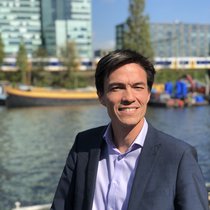What Monitoring & Sensoring technologies could gather information about the status of Amsterdam's Quay walls and Bridges? And how can these best be applied?
Innovation is key in answering these questions. Currently, at AMS Institute there are two research projects in place that can provide outcomes on how to manage a large area of quay walls and bridges in Amsterdam in a smart way. In short, these projects focus on:
- Ground imaging techniques to detect subsurface objects, changes in material properties, soil composition, and voids and cracks.
- “Proven Strength” as a methodology and relevance of updating reliability during service life or urban quay walls.
On October 14th, a knowledge exchange session was organised by the City of Amsterdam and AMS Institute; a successful step towards the process of building a Living Lab Monitoring & Sensoring – possibly at the Marineterrein – aimed at testing, assessing and whenever possible upscaling new innovative techniques. Ultimately, to significantly contribute to tackling the aforementioned questions.
During the meeting, valuable insights were gathered; required to speed up the City of Amsterdam’s Bridges and Quay walls program.
“Innovation and interdisciplinary collaboration are key to keep these historic canals safe, accessible, and guarantee overall livelihood in the city of Amsterdam. Its inspiring to have all these parties connect and discuss possible solutions to tackle these complex urban challenges.”
Kenneth Heijns
Managing Director
How to maintain 200 km of quay walls and 850 bridges?
The City of Amsterdam is responsible for the management and maintenance of a great number of bridges and quays. However, the fact of the matter is: for about 200 km of quay walls and 850 bridges there is not enough information available as of yet on what state they are in and what load they can still handle. To illustrate, there are no sufficient records of the composition of the soil around these walls; an important factor that determines the state of the quays.
That’s why, as part of its duty to keep the city safe, accessible and ‘future-proof’, the City of Amsterdam’s developed the ‘Bridges and Quay Walls’ Action Plan. As part of this plan, innovative methods are required to determine, among others:
- The current status of the bridges and quay walls?
- Which bridges and quays should be replaced or maintained?
- What is the cause of damage?
The City of Amsterdam’s program organization ‘Bridges and Quay walls’ is a mammoth task, for which AMS Institute has a network in place to help tackle the aforementioned questions. In line with the institute’s interdisciplinary and collaborative approach, this October 14th, a knowledge exchange meeting was organized.
The key question asked to experts of both businesses and knowledge institutes: what and how Monitoring & Sensoring technologies could best be applied to gather technical information about the structures of the Quay walls and Bridges of Amsterdam?
“Two hundred kilometers of quay walls and 850 bridges are to be investigated. The current aim of the City of Amsterdam is to have these renewed or maintained twenty times as fast as the current rate. To achieve this we need to innovate our current monitoring methodology.”
Casper van der Peet, Technical Manager Monitoring Bridges and Quay Walls, City of Amsterdam

Monitoring and Sensoring techniques
During interactive sessions, knowledge institutes and businesses raised questions and defined success criteria how to best monitor the city’s bridges and quay walls. Furthermore, an innovation market was set up, where participants showcased numerous Monitoring & Sensoring techniques, and the applicability in practice.
Requirements for these innovations were: robustness, scalability, accuracy, reliability, user convenience and financial feasibility.
To illustrate, one of the stakeholders suggested organizing a way for Amsterdammers to voluntarily keep an eye on bridges and quay walls. Another party showcased a camera that can detect cracks through sensor waves. And yet another visitor wondered what the City of Amsterdam is doing with data it already has.
Setting-up a Living Lab Monitoring & Sensoring
Together with City of Amsterdam, AMS Institute will process the results of the group discussions. Based on the input gathered, our research questions will be reformulated and we will further elaborate on the innovative measures to be used.
Subsequently, different stakeholders, from businesses to knowledge institutes, will be selected to set up a Living Lab Monitoring & Sensoring – possibly at the Marineterrein or throughout the city.
All in all, the 14th of October was a successful first step towards gaining insights from different perspectives on how Monitoring & Sensoring innovations can play a crucial role in the preservation of the historic bridges and quay walls infrastructure.

